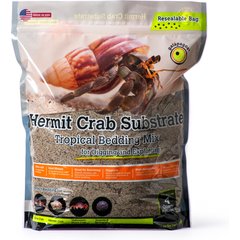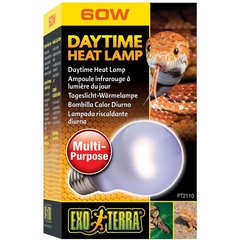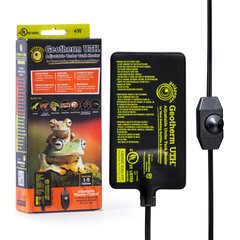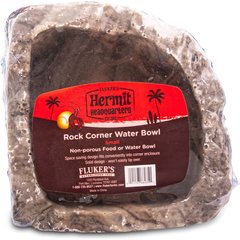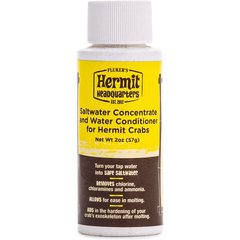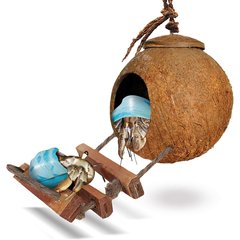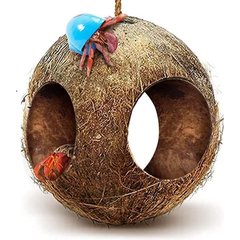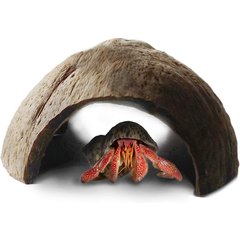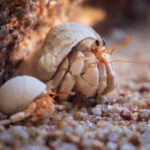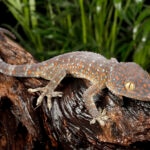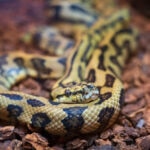How to Take Care of a Hermit Crab: A Guide to Your Tiny New Friend
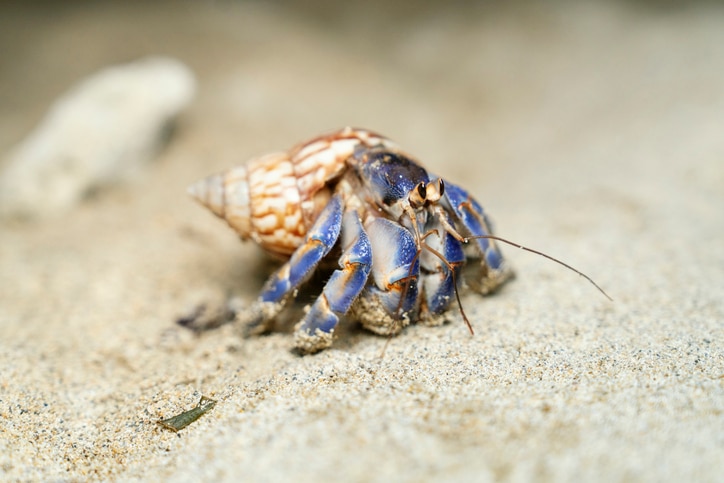
Photo by tdub303/E+
Hermit crabs may be small, but these unique creatures have specific needs that many pet parents aren’t aware of. Meeting those needs can make all the difference in how long, and how happily, they live.
From the right habitat setup to their daily diet, here’s everything you need to know about how to take care of a hermit crab.
Key Takeaways
- Hermit crabs need warm, humid environments with substrate for safe molting and growth.
- Provide your hermit crabs with multiple unpainted shells, separate freshwater and saltwater dishes (never tap water), and a varied, balanced diet.
- Hermit crabs are social animals. Keep more than one and give them space to climb, dig, and explore.
- Handle them minimally, keep their habitat clean, and monitor molting closely for good health.
Caring for Your Hermit Crab
Hermit crabs are tropical crustaceans, or more specifically, arthropods, which means they have a hard outer covering called an exoskeleton.
While they’re often sold as starter pets, they require just as much care and attention as other animals. In that sense, they’re not “easy” pets, as many people think.
In fact, hermit crabs go through a process called molting, where they shed their old exoskeleton and form a new one.
Molting can take weeks, and during this time, crabs bury themselves under the sand for safety and shouldn’t be disturbed, says Mary Akers, a hermit crab expert and the founder and director of Hermit House.
Successful molts are essential for a hermit crab’s health and longevity, so creating the right environment is key.
Because their bodies continue to grow with each molt, hermit crabs also need access to a variety of extra shells to move into when they outgrow their current ones.
Akers recommends always giving them three to five unpainted shells to choose from. The shells should be the right size, with wide enough openings to fit their body.
Never give your hermit crab a painted shell. The paint is toxic if ingested.
How to Create the Perfect Home for Your Hermit Crab
While giving hermit crabs the space and tools they need to molt safely is critical, so is ensuring all their other basic needs are met.
Here’s how to give them the perfect hermit crab habitat:
Enclosure
A hermit crab tank should be a glass aquarium, like the Tetra Glass Aquarium, rather than a wire cage or plastic carrier. An aquarium helps retain humidity, while still allowing for proper ventilation.
Recommended Product
While hermit crabs are small, they need space to thrive. A 20-gallon tank is the minimum size for two crabs, but bigger is always better, says Stacy Griffith, president of the Land Hermit Crab Owners Society and author of The Complete Guide to Land Hermit Crabs and Their Care.
Substrate
The right substrate, the material used to line the bottom of the enclosure, is also critical for safe molting.
It should be a mix of play sand and coconut husks or fiber (about a 5:1 ratio) and deep enough for your hermit crabs to completely bury themselves, Griffith says.
The Galapagos Natural Hermit Crab Substrate is a good option.
Recommended Product
When filling the tank, a good rule of thumb is 6 inches deep, or at least three times the height of your largest crab. This depth is essential for safe molting.
Light
Hermit crabs rely on day-and-night cycles to regulate their behavior and molting patterns.
Use a low-wattage bulb or full-spectrum light, like the Exo Terra Daytime Heat Lamp.
Recommended Product
Keep the light on for 12 hours during the day and then turn it off at night.
Heat
Since hermit crabs come from tropical climates, they thrive in a warm environment between 75 F and 85 F. Humidity levels should be kept at 70% to 90%, says Griffith.
A heat lamp or an under-tank heater, like the Galapagos Geotherm, work best to maintain temperature, and you should continually monitor conditions with a thermometer and a hygrometer, which measures humidity levels.
Recommended Product
Water Dishes
Hermit crabs need two water dishes to thrive. One should be filled with fresh water, ideally distilled or bottled.
Recommended Products
Tap water is not recommended because it usually contains chlorine, which is toxic to hermit crabs.
If you must use tap water, treat it first with a water conditioner that removes chlorine and chloramines.
Recommended Products
The other water dish should be filled with ocean/marine saltwater.
Fill both dishes just high enough that your crab can wade in up to their eyes. It shouldn’t completely cover them, since this can increase the risk of drowning.
Friends
Hermit crabs are social creatures. In the wild they live in large colonies, and they do best as pets when housed with other crabs.
Adopt more than one crab so they have the social life they need.
Enrichment
In the wild, hermit crabs walk for miles, so they need lots of opportunities to climb and walk.
Akers recommends including a hamster saucer in their habitat to keep them active and happy.
Recommended Product
They also love to climb and hide, so hideaways can be fun too.
Recommended Products
How to Clean Your Hermit Crab’s Home
A clean habitat is key to your crab’s health. Uneaten food and waste can quickly break down in a warm, humid environment, leading to mold and bacteria, which can be dangerous for your crab.
To keep your crab healthy:
- Remove uneaten fresh food daily.
- Rinse and refill water bowls every day.
- Boil empty shells and other heat-resistant items (don’t boil rocks).
- Deep-clean the entire tank every one to two months by replacing substrate and scrubbing toys and decor with hot water (no soap).
When you’re deep-cleaning your hermit crabs’ habitat, make sure you have a temporary house set up with the right temperature and humidity—a 10-gallon tank works well for this, Griffith says.
How Should You Hold Your Hermit Crab?
In the wild, being lifted feels like a predator attack, so being held is stressful for hermit crabs. Avoid contact as much as you can.
If you do need to pick your hermit crab up, gently scoop them from underneath using a piece of bark instead of grabbing them directly.
Avoid handling during or right after molting.
What Do Hermit Crabs Eat?
Hermit crabs need nutrition from all food groups to be their healthiest, according to Griffith. He says protein and healthy fats are vital for healthy molting and growth.
Because there’s no way to predict what a hermit crab “needs” on a given day, Griffith recommends offering a variety of food, including:
- Proteins: fish, eggs, mealworms, shrimp, chicken, beef
- Fruits: apple slices, bananas, honeydew melon, berries
- Vegetables: broccoli, carrots, sweet potato, zucchini
- Grains and nuts: oats, rice, popcorn
- Calcium sources: crushed cuttlebone, oyster shell, powdered eggshell, garbanzo beans
FAQs About Hermit Crab Care
When does a hermit crab need to see a vet?
An exotic-pet veterinarian with experience in hermit crabs can be difficult to find. Even if you do, they may not be able to offer a lot in terms of treatment or diagnosis. The best thing you can do is to make sure they have what they need to molt: Give them deep sand to bury themselves in, the time and space they need, and shells to pick from. Hermit crabs are helpless as they harden up post-molt, and there’s no way to tell how long that will take.
When do hermit crabs need new shells?
Hermit crabs need new shells as they grow, but some hermit crabs will want to change shells even when they’re not growing. Because of this, you should always give them access to new shells.
Is it ethical to have a hermit crab as a pet?
All pet store hermit crabs are wild-caught, so it is best to adopt an unwanted hermit crab instead of buying one.
Do hermit crabs need baths?
Baths aren’t necessary. Access to two separate fresh and saltwater pools is enough for them to keep themselves clean.
How do I keep my hermit crab happy?
Provide a proper tank setup with enough space, deep substrate, and companions, and make sure they have a varied diet. Enrichment items help keep them active and engaged.

